To say the retail industry is ever changing is an understatement. Brands have to move fast, be agile with their products and know the ecommerce trends happening now and always be thinking about what’s to come.
Not to keep retailers up at night, but the competition is getting more intense each year as more brands move to digital platforms. According to data from Statista, ecommerce is expected to make up nearly 14% of total global retail sales and possibly reach closer to 18% by 2021.
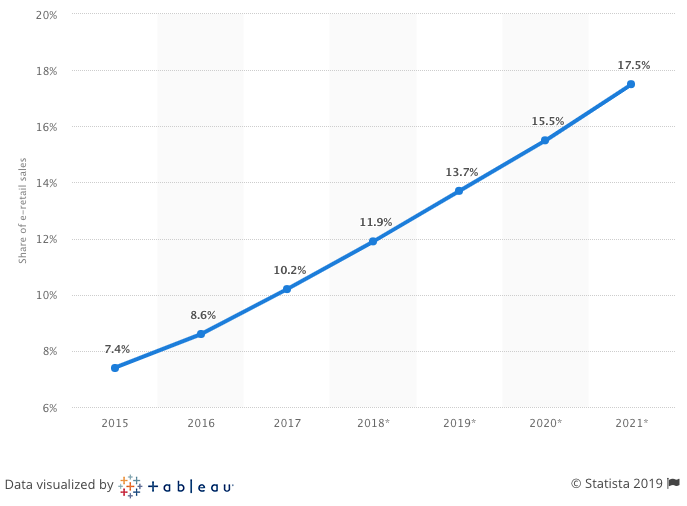
It’s safe to say consumers are back in the buyer mode, but now they’re influenced by things like social media, digital ads and word of mouth from friends and family. With the economical changes over the past decade, many shoppers got smarter about how and why they make their purchasing decisions, whether it’s online or not.
However, it’s not all doom and gloom for retailers trying to get ahead in the digital marketing age. As the year begins, we compiled data around the industry to determine what you should look for in the upcoming year.
That’s why we’re here to provide you with five ecommerce trends in 2019 that brands have to know in order to stay ahead:
1. Brands Will Tell Better Product Stories
Research is at the forefront of every buyer today. And in 2019, this movement toward better product descriptions and information will be more crucial than ever. This is why brands have to up their game when it comes to telling the story of their products.
Did you know when consumers research your products online, 43% get upset or irritated with poor product descriptions? What’s even more telling is data from CNBC that showed 40% of the typical apparel products bought online are returned. This is a huge waste of everyone’s time and money.
So where do you start to fix this growing problem? Improve your copy and tell a better story.
Descriptions Go a Long Way
One of the most essential ecommerce trends in 2019 will be brands investing in product descriptions that not only better explain what they’re buying, but provide enough information to inspire confidence in their purchase.
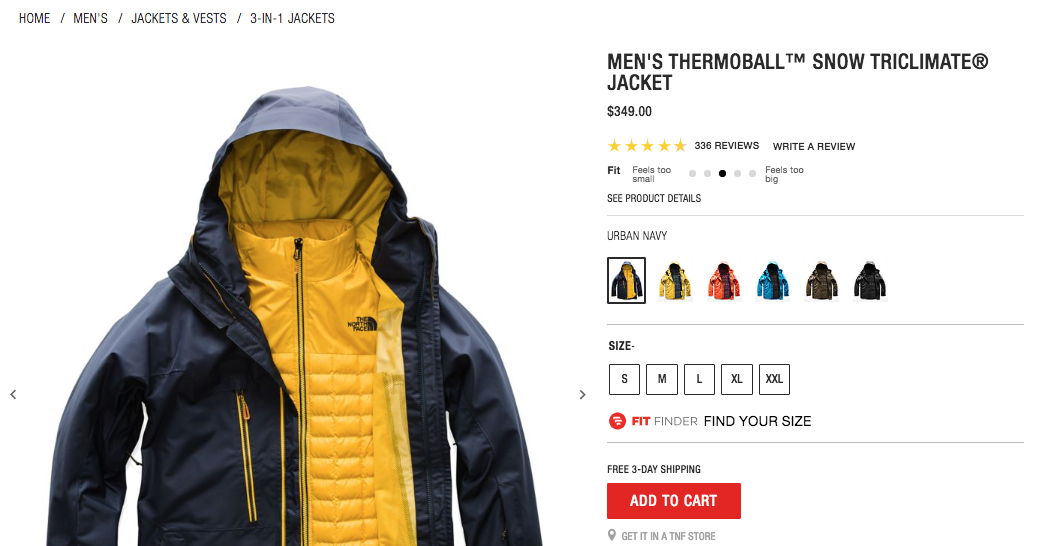
For example, The North Face does a fantastic job at detailing sizes and warmth levels for their jackets and coats, so buyers have no doubts when they click “add to cart.” You can see there’s plenty of storytelling here from The North Face in their descriptions and product information, which helps their items rank better organically on search for relatable search terms.
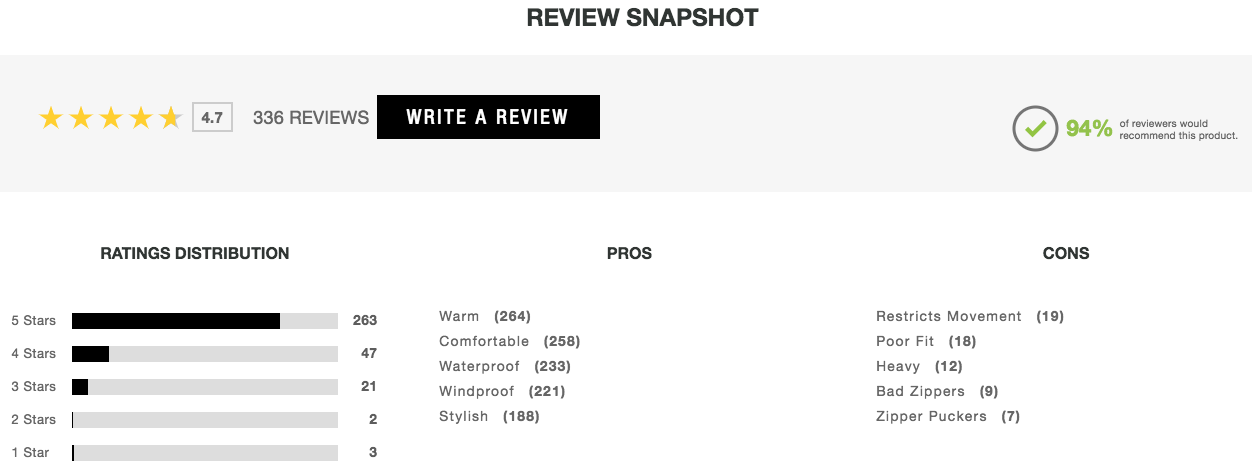
Remember–you don’t have to be an Ernest Hemingway with your product storytelling. Consumers simply want to know what they’re buying. So the more copy you add, the safer they’ll feel about their buying decisions.
In fact, Salsify found 87% of consumers believe good product content and descriptions are “extremely important” when buying online. Some brands might be thinking they don’t have capacity to write in-depth product descriptions for the thousands of products they sell.
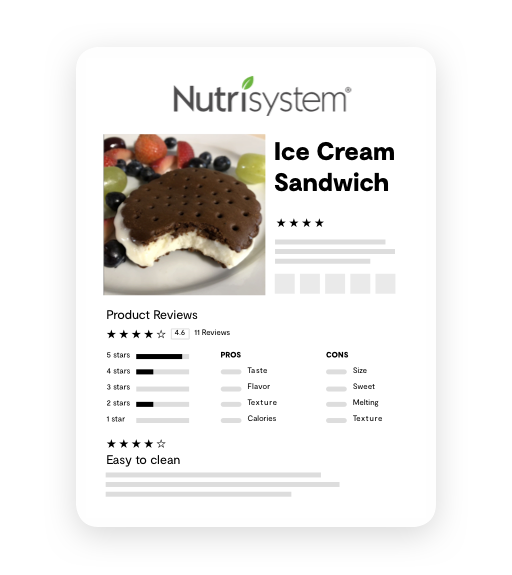
But with the help of PowerReviews, brands have the ability to implement Ratings and Reviews software to drive more content from their own customers. Finding time to add descriptions to every product isn’t a small task, but through visual content and more reviews, you easily tell a better story of your product.
2. Social Media Will Play a More Critical Part in Product Discovery
We shouldn’t have to sell you too hard on the importance of social media and marketing. But there’s still some debate on the impact of social media with retail sales.
The Salesforce Shopping Index found that in Q1 2018 less than 5% of website visits for ecommerce brands came from social media channels. Even more so, the same report said approximately 2% of digital orders started on social media.
However, we just talked about the rise of consumer research in our last ecommerce trend and how it’s impacting sales. Again, this means a lot people are doing their due-diligence before making a purchasing decision.
Even if consumers aren’t buying online, they admit it has an influence on their in-store purchases. The PowerReviews report Mapping the Path to Purchase noted 56% of in-store purchases are heavily influenced by digital commerce efforts.
The Rise of the Everyday Influencer
What’s also important to know is the value of influencer marketing through social media. More consumers trust the opinion of their peers over brands, paid celebrities and more.
https://www.instagram.com/p/Br7vAcPgN83/
This is why social media will continue to be a resource for consumer product discovery. More brands are seeing value from the everyday influencer than the celebrity social advertisement.
The shift is all but likely to grow among ecommerce trends in 2019 as brands use product sampling partners to get real reviews from trusted sources. A report from Forrester said almost half of U.S. adults actively avoid ads online.
There’s so much more importance on brands reaching bigger audiences without over targeting consumers with social media ads. Even though there’s definitely benefits to paid social, the shift toward everyday influencers could become the staple of retail marketing in 2019.
3. Consumer Trust Will Need More Personalization
Another one of the ecommerce trends in 2019 to look for will be around further personalization in products for consumers. This means brands shouldn’t just target everyone with the same copy, visuals and sometimes even pricing. Instead, brands should funnel consumers to specific items that fit their exact needs.
The PowerReviews Custom Review Display allows retailers to better personalize information to consumers through features like Size and Fit.
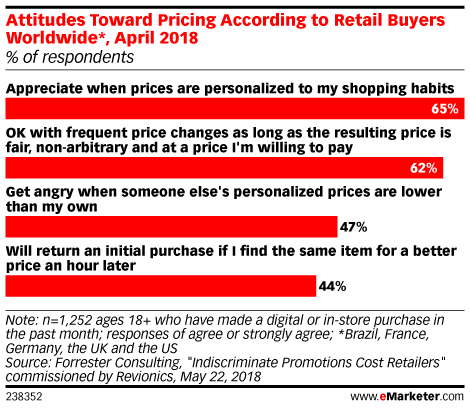
A 2018 report from Forrester discovered 65% of consumers like it when product prices are personalized to their specific buying habits. This is an interesting statistic because it further proves consumers like to be considered unique. They also value experience and want to be rewarded for brand loyalty.
In fact, a Frost and Sullivan study found customer experience will be the main priority for brands by 2020, which would jump pricing and product. Brands are beginning to shift toward more authentic marketing efforts to stay transparent.
Why are personalization and authenticity such critical ecommerce trends in 2019? The annually updated Edelman Trust Barometer evaluates consumer trust with brands. And in 2018, only 48% U.S. respondents said they trust businesses. Compared year over year, that’s a 10% drop with faith in brands.
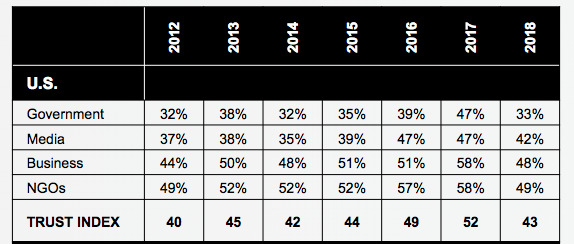
How to Quickly & Easily Increase Consumer Trust
It’s not necessarily rocket science, but gaining consumer trust starts with something as simple as effort. Like we’ve mentioned, personalization is a great tool for consumer trust and it helps shoppers know their time and money are valued.
If you’re looking for few quick and easy tips to build consumer trust, here’s a list of tactics to consider in 2019:
- Collect Information on Your Shoppers: If you dig deep enough, you can collect demographics and use case data and use it to build more trustworthy products. With a tool like Progressive Collection from PowerReviews, shoppers provide more insights for the products they bought through reviews. This provides more depth to product pages through detailed questions about items such as size, fit and best uses.
- Look into Previous Customer Journeys: Did a customer visit a product page more than once? Did they sign up for your newsletter for exclusive deals? Reward these customers with personalized deals highlighting the products they’re most interested in. Use past customer experiences to better personalize their future interactions. This builds trust by showing returning customers products they actually want.
- Let Your Customers Share Content: Your customers want to be confident in the products they buy online and in store. Make sure you provide several avenues through Reviews and Ratings and Question and Answer software to get your consumers’ voices heard. This builds trust by showing your audience you care about them picking the right size, color or item through previous customer reviews.
4. Brands Will Invest in Interactive & Visual Content
There’s no doubt we live in a highly-visual age–and the standard single or three product images don’t quite cut it anymore. For example, Wayfair now allows customers to use their smartphones to take pictures of products and find them in their store.
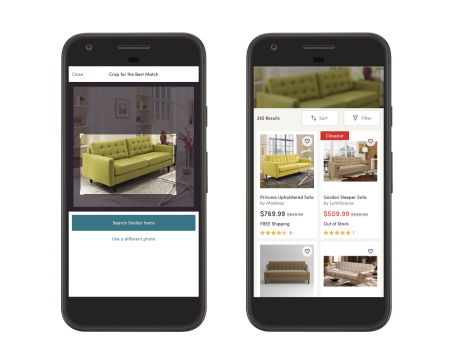
This kind of visual content adaptation is making it easier for consumers to find the exact things they want when buying something online. Product visuals not only build trust–like we just mentioned–but they also fill various content gaps.
And as you might guess, consumers really do enjoy browsing through more visuals before they make a purchase decision. In fact, the PowerReviews Snapshot for Ecommerce report found 20% of shoppers aren’t very happy when there’s a lack of product photos and videos online.
Still not convinced on the power of visual content for your products? The same PowerReviews study also discovered just 3% of shoppers don’t seek out any visual content when looking to make a purchase. And on the flip side, 40% always search for photos and videos prior to a purchase.
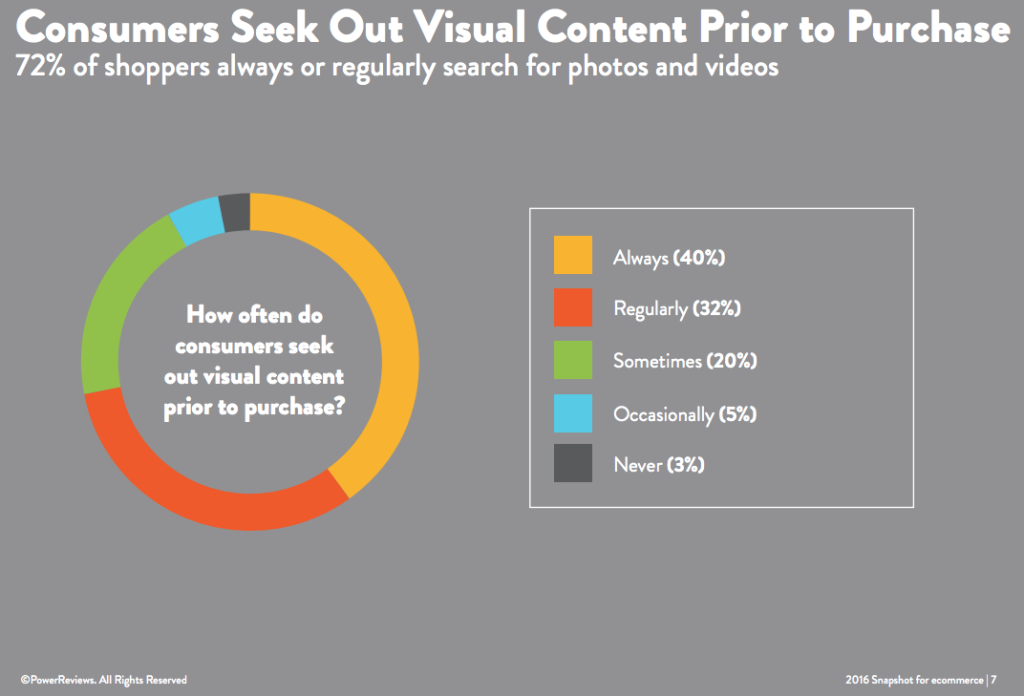
The demand for mobile-friendly content is just as important too. Many shoppers in today’s ecommerce market do their buying on a mobile phone. A Vision Critical infographic stated 82% of chief information officers say they’re focused on better mobile experiences for their businesses.
Collecting and displaying visual content for products has to be as seamless on desktop as on a mobile device. Make sure you’re properly loading content and at good enough speeds to avoid frustration with potential customers. Typically, retailers should aim for under 3 seconds, according to MachMetrics, compared to the US average of 9.8 seconds.
Professional Visual Content Is Not Enough
Providing better visual content isn’t a new concept to a lot of businesses. Brands know that high-quality images, videos and websites raise the bar for shoppers. And many companies will put the money behind professional photography and videos to highlight their products.
However, high-quality product photos and videos aren’t the end all to making shoppers comfortable to purchase. The growth in user-generated content has more consumers looking for authentic visuals from customers just like them. People want to see how a couch looks in a living room similar to theirs or a makeup product on the skin of someone similar.
https://www.instagram.com/p/BsIC65ggdUS/
The same PowerReviews Snapshot for Ecommerce study found 42% of shoppers believe it’s important or very important to include user-submitted content like photos or videos in product reviews. When looking at those between the age of 18-29, the demand for user-submitted content jumps to 58% of consumers.
It’s hard for consumers to see polished and intensely-edited content as a relative source of truth for products. There’s more personality and a better story behind products that show user-generated content on product pages.
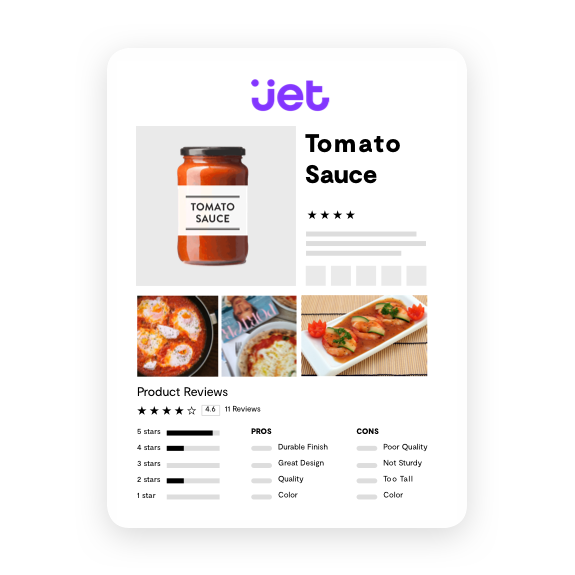
With PowerReviews, brands and retailers rely on the Social Suite to collect photos and videos from major social media channels, match this content to their products and display this content in the Visual Content Gallery on their product pages, alongside natively collected images and videos.
5. Balance Between Ecommerce & In-Store Sales Will Grow
Filling the gaps between in store and online have been a priority for businesses for several years. The problem many continue to face is the siloing between the two avenues and treating each as their own separate entity.
Another major ecommerce trend to watch in 2019 is the growing connection between online and offline sales. Again, the omnichannel movement isn’t anything new. But with more shoppers abandoning carts or complaining about the lack of information in-stores, the need to help shoppers create better overarching purchasing decisions is strong.
Forrester data found 55% of U.S. adults will leave their online purchases in the cart if they can’t find a quick answer to their product question. But at the same time, a report from June 20 said more than 30% of consumers feel brick-and-mortar companies lack in-store product information and content.
The balance between these two sales funnels is dependent on creating trust in the products with helpful content describing the items for sale. Use review content to build shopper confidence across the board.
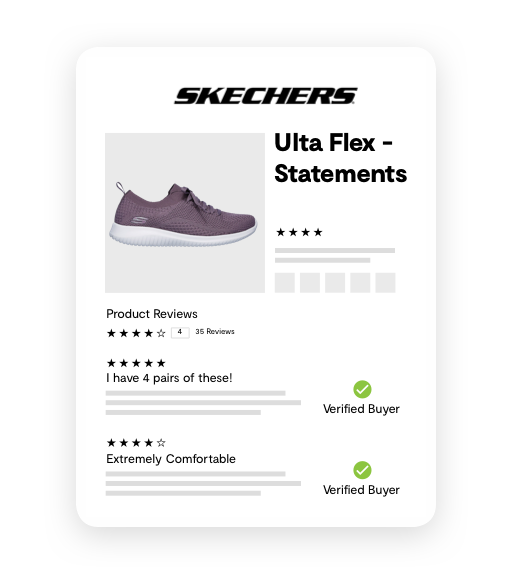
Why? Well 72% of shoppers said they’ll likely make a purchase if the product has written text reviews and visuals. Additionally, another 20% admitted they’d be more likely to make a purchase if they found these reviews included user-submitted content.
Speed of Shipping Will Always Be a Pain Point
Unsurprisingly, consumers demand faster, easier and cheaper shipping options today. For businesses balancing their in-store and online options, 2019 should be the year to get more creative.
The biggest complaint for post-purchase shoppers is receiving a product that didn’t meet their original expectations (48%). However, product returns for retailers accounted for roughly $400 billion in 2018, which is a 53% spike in just three years.
https://www.instagram.com/p/BsHR019AN4r/
More retailers are offering free shipping and returns, but at what cost? The need to limit product returns is growing, and one way to address this issue is with better product descriptions. Rely on trusted Ratings and Reviews software to add more content to product pages so shoppers can make better purchasing decisions.
And this doesn’t exclude the in-store shopper. In fact, the previously mentioned Mapping the Path to Purchase study found 48% of shoppers are likely to do research online before ultimately deciding to make their purchase in-store. These two channels have to work together and provide shoppers with the best content available.
Looking Ahead to 2019
As 2019 begins, retailers and brands have to prepare their marketing and sales teams for another successful year. Take these statistics from last year and be ready to learn from industry trends and make improvements in the future. We wish brands the best of luck toward 2019 and hope these ecommerce trends point you in the right direction this year!





